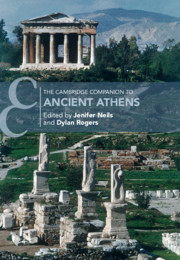Book contents
- The Cambridge Companion to Ancient Athens
- Cambridge Companions to the Ancient World
- The Cambridge Companion to Ancient Athens
- Copyright page
- Contents
- Contributors
- Abbreviations
- Athens: An Introduction
- 1 #Leagros: An Athenian Life
- Part I The Urban Fabric
- Part II Inhabitants
- Part III Business/Commerce
- Part IV Culture and Sport
- Part V Politics
- Reception
- Index
- References
Reception
Published online by Cambridge University Press: 10 March 2021
- The Cambridge Companion to Ancient Athens
- Cambridge Companions to the Ancient World
- The Cambridge Companion to Ancient Athens
- Copyright page
- Contents
- Contributors
- Abbreviations
- Athens: An Introduction
- 1 #Leagros: An Athenian Life
- Part I The Urban Fabric
- Part II Inhabitants
- Part III Business/Commerce
- Part IV Culture and Sport
- Part V Politics
- Reception
- Index
- References
Summary

- Type
- Chapter
- Information
- The Cambridge Companion to Ancient Athens , pp. 419 - 481Publisher: Cambridge University PressPrint publication year: 2021
References
Further Reading
Over the course of the last three decades, scholars have begun to pay greater attention to the city of Athens in the Roman period, a time often overlooked in light of the glories of the Classical period. Important edited volumes on a range of topics include Hoff and Rotroff 1997, Ostenfeld 2002, Vlizos 2008, Caliò et al. 2012, Dijkstra et al. 2017, and Di Napoli et al. 2018. See the work of the Roman Seminar in Athens, which hosts an annual international lecture series on topics related to Roman Greece (http://sites.google.com/view/romanseminar), along with the Ancient Athens 3D project for digital reconstructions of monuments of Roman Athens and other time periods of Athenian history (www.ancientathens3d.com). For a succinct discussion of the monuments installed in the city under the Romans, see Raja 2012, 92–135, including issues related to regional identity, along with Rous 2019, especially 198–209, and Yegül and Favro 2019, 579–595. Late Hellenistic Athens is explored in Habicht 1997. On issues related to Athens under the rule of Augustus, see for example Spawforth 2012. The role of Hadrian and Athens can be found in a number of new publications, including Lagogianni-Georgakarakos and Papi 2018. See Tobin 1997 for a discussion of the construction projects of Herodes Atticus. Those interested in learning more about Christian Athens can turn to the work of Baldini (e.g. in Caliò et al. 2012); on Byzantine Athens, see most recently Bouras 2017; and on Ottoman Athens, see Georgopoulou and Thanasakis 2019.
Bibliography
Additional resources to accompany this chapter can be found at: www.cambridge.org/NeilsRogers
Further Reading
For Athenian monuments and sources in the Byzantine period, see Kaldellis 2009 and Bouras 2017. For detailed bibliographic information of the publications of the early travelers to Greece, see Paton 1951, Weber 1952 and 1953, Navari 1989, and for a collection of images from these works, Tsigakou 2007. The story of travels to Athens is told by Laborde 1854, and travelers within their intellectual and cultural context are discussed in Tsigakou 1981, Stoneman 2010, and Constantine 2011. Accounts of individual travels and missions include: for Cyriacus of Ancona, Bodnar 1960 and Chatzidakis 2017; for the Dilettanti Society, Kelly 2009; for Stuart and Revett, Weber Soros 2006; for Dodwell, Camp 2013; and for Fauvel, Zambon 2014.
Bibliography
Additional resources to accompany this chapter can be found at: www.cambridge.org/NeilsRogers
Further Reading
For more on the development of architecture in modern Athens and Greece, see Tzonis and Rodi 2013. On the history and development of Athens as a city and capital of Greece, see Travlos 1981, Bastéa 2000, Papageorgiou-Venetas 2001 (in Greek, but well illustrated), and Beaton 2019 (with previous bibliography); further, see Hamilakis 2007 on the relationship between modern Greece and its ancient past. See Scully 1963 for an entertaining exploration of the relationship between Kleanthes and the Duchess of Plakentias. The Akropolis in the nineteenth century has been presented by Carter 1979 and Tomlinson 1987. The work of Danish architects in Athens in the nineteenth century has been explored by Bendtsen 1993 and Cassimatis and Panetsos 2014 (in Greek), along with Kardamitsi-Adami 2006 on the architecture of Ziller. Biris and Kardamitsi-Adami 2005 offers a lavishly illustrated introduction to Neoclassical architecture in Greece. Dumont 2020 explores the neighborhood of Vrysaki in Plaka that was razed with the start of the excavations of the Athenian Agora in 1931.
Bibliography
Additional resources to accompany this chapter can be found at: www.cambridge.org/NeilsRogers
Further Reading
Petrakos has published extensively on the history of Greek archaeology, the contributions of individual prominent archaeologists, and the role of institutions, such as the Archaeological Society of Athens (e.g. Petrakos 2011, 2013). Hamilakis 2007, Bastéa 2000, and others discuss the role of antiquities in the construction of the Greek national narrative in a growing corpus of scholarship. On the early history of the foreign archaeological schools in Athens, see Whitling 2019. Archaeological reports of rescue excavations and new finds can be found in the annual volumes of the Archaiologikon Deltion and online (http://chronique.efa.gr). Judith Binder (1923–2013) had a deep knowledge of Athenian archaeology, especially the literary sources concerning the city. An avid opponent of Travlos, she challenged many of his identifications of ancient monuments. She has left two unpublished major resources on the study of Athens: The Monuments and Sites of Athens: A Sourcebook and The Monuments and Sites of Athens as They Were Seen, Described, and Investigated from 1102 to 1997, focusing on the history of excavations in the city. The most recent survey of the topography of ancient Athens can be found in the volumes of the Topografia di Atene by Greco (2010–2015).

